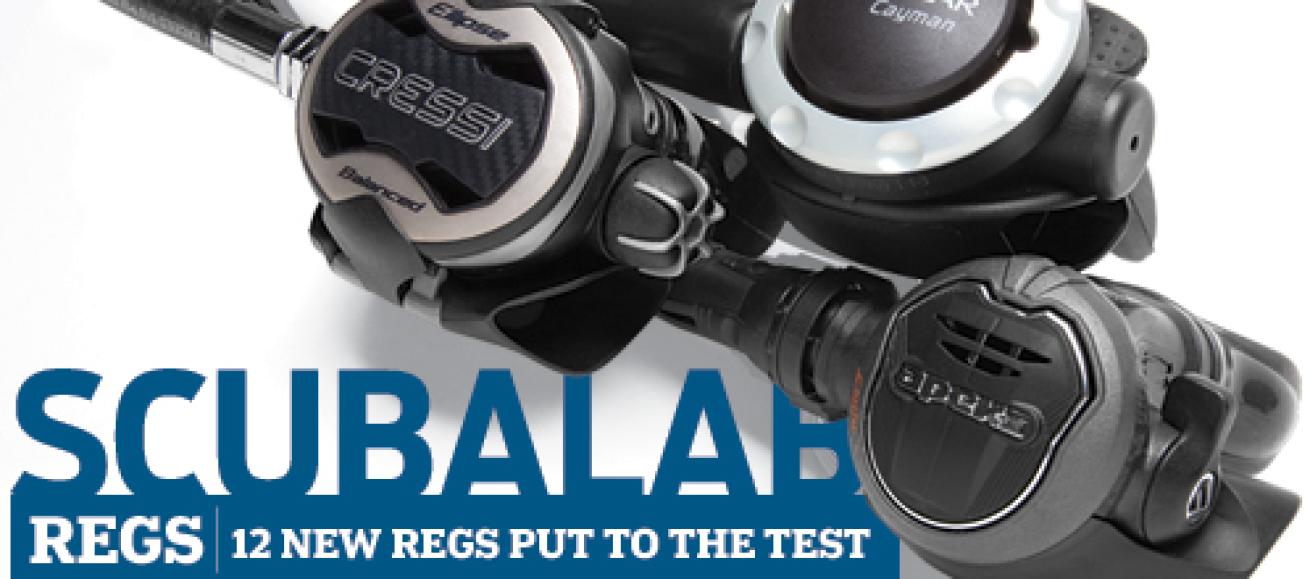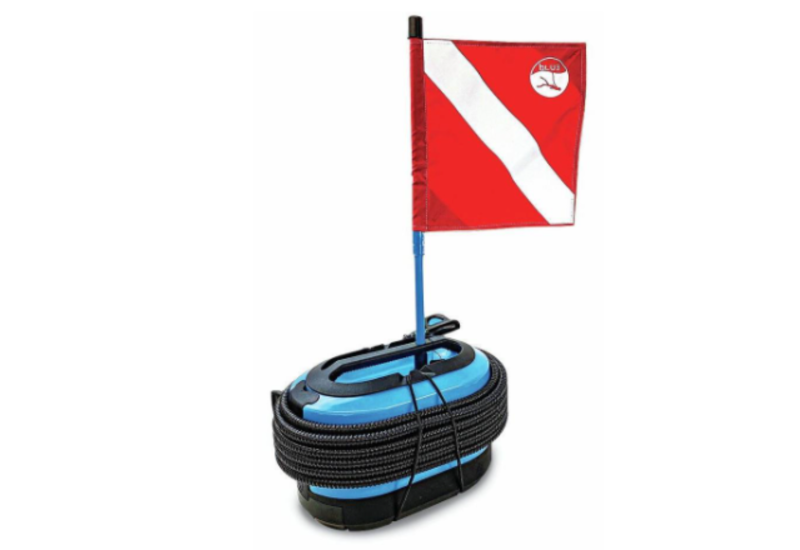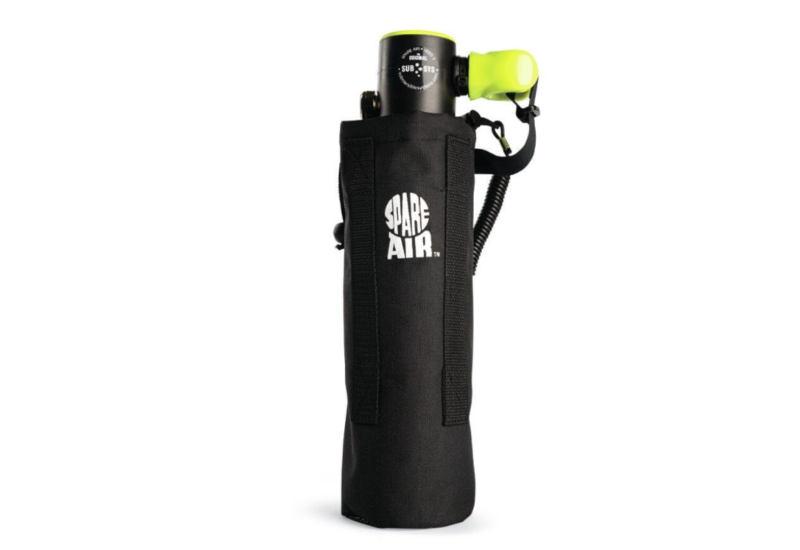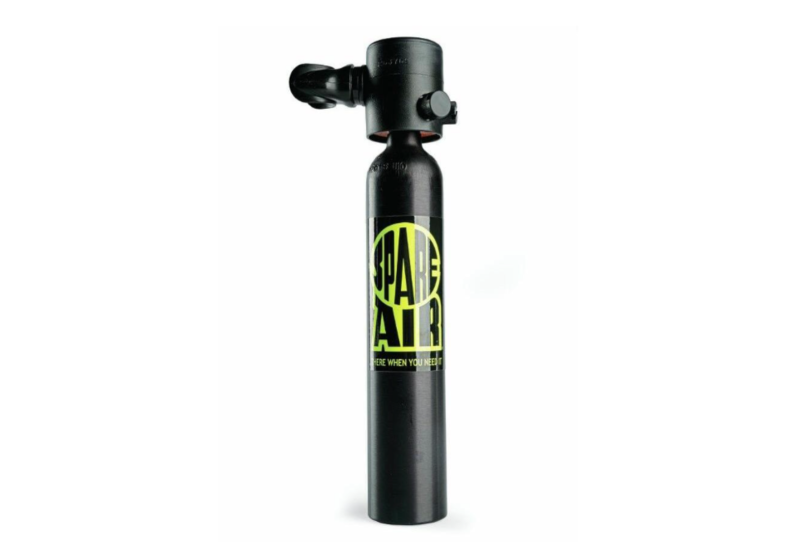ScubaLab: Regulators

|July 2010 Issue Scuba Lab Review Quick Links|
|---|
|Over $500|
|---|
| Apeks Flight| Cressi Ellipse MC9 Balanced|
| Oceanic Delta 4.2 & Neo| SCUBAPRO MK25/S600|
| Zeagle Flathead 7/Z & Flathead LT/Z| |
|Under $500|
|---|
| Agua Lung Titan| Cressi MC5 Steel|
| Sherwood Brut| Subgear Aruba|
| Subgear Bonaire & Cayman| |
You want a nice breather but don’t have a lot of cash? We’ve got one of those. How about a reg capable of taking you down into the abyss? Got one of those too, along with 10 more models that fall in between. The regulators that arrived at ScubaLab’s shop for this year’s review are a perfect representation of the new range of breathers available today, and all are loaded with diver-friendly features. Whether you’re shopping for entry-level or cutting-edge, easy-on-the-budget or money’s-no-object, one of these regs will fit your style of diving. Each year, ScubaLab subjects new regulators to diving’s most comprehensive — and rigorous –– level of gear evaluation. It starts in the ScubaLab shop where regs are unpacked, inspected and put under pressure to make sure all systems are “go.” Staffers study owner’s manuals and product literature to learn as much about each reg before getting down to the real business at hand.
The Breathing Machine Tests
At an independent test facility in Panama City Beach, Florida, ScubaLab hooks regs to a state-of-the-art ANSTI breathing simulator and takes them through a repeatable test protocol (see below) that has been established as a result of more than 10 years of testing. This year, more than 200 data points and 80 pages of breathing “loops” (a graphic representation of a regulator’s inhalation and exhalation performance) were captured, recording in detail each reg’s behavior when taken through a series of test depths and breathing rates. Breathing simulator results are important, but they represent only half the story. A machine can tell you how hard or easy a regulator works to deliver gas at certain depths and breathing rates, but it can’t indicate when a regulator stutters or whistles, when a purge is so stiff that clearing is difficult or if a regulator chokes a diver with water when inverted at 50 feet. In other words: To capture the complete picture, we also need to consider a reg’s ergonomic performance.
The Ergonomic Tests
This year, the ScubaLab test team of six test divers and one on-deck supervisor spent two days on the Body Glove dive boat Disappearance off the coast of Southern California, putting these regs through their paces in a real-world diving environment. Divers rated each reg in seven specific ergonomic categories (see below), using underwater slates with specially prepared waterproof sheets preprinted with the testing protocol. Test divers use a 1 to 5 rating system to score each area of performance. An additional sheet is supplied so divers can expand on their scores with written comments.
Observations
- It seems every year regs get lighter. Not so long ago, it wasn’t unusual to see regs weighing in at more than 3 pounds. This year, the heaviest reg we tested is a few ounces under that, a handful come closer to 2 pounds, and two are even lighter. This is a good trend for traveling divers, who know every pound of unnecessary gear weight equals another bite in the wallet because of airline baggage fees. - Second stages are getting smaller too, along with their exhaust tees. While no regs were dinged this year for excessive bubble interference, none really stood out as having substantially less-than-average bubble interference. Since all regs were rated pretty middle-of-the-road for bubble interference, this test category wasn’t mentioned in the individual reviews. - All regs in this review are available in both DIN and yoke versions. - While this wasn’t discovered during our tests, we’ve gotten reports from the field that the popular new braided regulator hoses –– lightweight and highly flexible –– tend to get needlelike fibers jutting out of the braid when chafed. This can be hard on bare hands. Recreational divers who don’t typically experience gear chafe don’t usually need to worry about this, but tec divers, who commonly find their gear rubbing up against steel openings or cave walls, might be better served with a more traditional style of hose with a rubber cover. The Results: The 500-plus ergonomic data points that test divers collected, along with more than 70 waterproof pages of comments, were folded in with the breathing simulator data to determine this year’s best breathers. The reviews that follow are based on these test results.
The Nuts and Bolts of Breathing Machine Tests
- Following a surface check, each regulator is tested at three different breathing rates, known as Respiratory Minute Volumes — basically, the amount of gas that can be ventilated through the lungs in one minute, at three depths, for a total of four RMV/depth combinations. These breathing rates were chosen to 1) simulate a recreational diver’s breathing rate; 2) conform to recognized industry testing parameters for purposes of comparison; and 3) surpass normal breathing rates to determine reserve capacity (the ability to continue to deliver gas smoothly and easily, even at extreme depths and breathing rates). - Tests are performed at a supply pressure of 725 to 760 psi to conform to the European conformance standard EN250 for evaluating regulator performance, currently the world’s dominant testing authority on regulator performance. This low-supply pressure exerts additional stress on the regulators. Tests have shown if a regulator can perform well at this supply pressure, it will perform as well or better at higher supply pressures. - Simulator tests are not intended to pass or fail regulators, but rather to scientifically gauge their performance based on controlled conditions. Following are the RMV/depth combinations that ScubaLab uses to test regulators, what they represent and how you can apply them to real-world diving situations. 37.5 RMV @ 132 FEET This test point is the one that most closely represents typical recreational diving. The depth, 132 feet, is the maximum depth recommended for recreational divers, and the 37.5 RMV breathing rate is very close to how a physically fit recreational diver breathes while swimming a long distance (for comparison, a relaxed diver doing a drift dive or taking photographs breathes at about 22 RMV or less). A fit diver could theoretically maintain 37.5 RMV for five minutes or longer without becoming significantly winded. From an engineering standpoint, this rate also gives a good view of the smoothness of a regulator’s demand valve, and it provides a consistency curve when compared with higher RMVs. 75 RMV @ 132 FEET Only the U.S. Navy and ScubaLab use this breathing rate to identify equipment potential or limitation. This is considered an extremely heavy work-breathing rate. A diver in excellent condition can breathe at 75 RMV for only about a minute. Beyond determining a regulator’s reserve capacity in high-stress conditions, this rate also provides a pretty good indication whether a regulator is capable of supporting two divers at the maximum recreational depth while buddy breathing (75 RMV divided by two equals 37.5 RMV). While this is not scientific, it offers a reasonable indication as to whether the regulator can accomplish the goal easily, with difficulty or not at all. 62.5 RMV @ 165 FEET This is the standard test depth and “high work rate” used by the European conformance standard EN250. Consequently, it is the test point of highest interest among regulator manufacturers. Considered to represent “heavy work,” a recreational diver in excellent condition aggressively chasing a huge bat ray through open water would be able to maintain 62.5 RMV for only two or three minutes. 62.5 RMV @ 198 FEET This is the U.S. Navy’s Class A test depth and breathing rate (although the Navy uses a higher supply pressure in its reg testing). This is a test point designed to stress a regulator to find the outer limits of its reserve capacity. 75 RMV @ 198 FEET (aka Above and Beyond) Every reg that reaches the 62.5 @ 198 test level is rewarded by having its breathing rate kicked up another notch, just to see what happens. Most regs hit the mat when this switch is flipped — they just can’t withstand the extreme depth coupled with the extreme breathing rate. Some regs, however, keep right on trucking. We’ve dubbed these the “muscle regs.” For divers who stay within the boundaries of recreational diving, this designation might be of little interest. But for those who like to push the envelope –– wreck divers, deep divers, etc. –– it’s nice to know what kind of reserve capacity a reg offers in the event you find yourself diving the outer limits.
Ergo Tests Explained
ScubaLab staff evaluates each reg in water in seven basic areas, divided into three categories: Most Important, Moderately Important and Convenience Elements. Most Important Ease of Breathing -- How well does the regulator deliver air when the diver is propelling himself forward in the standard swimming position? Different Positions -- How well does the regulator deliver air when the diver is in a heads-down vertical or face-up horizontal position? Dives Dry During normal swimming and when in odd positions, is the regulator a dry breather? Moderately Important Bubble Interference -- Taking into account that all regulators have bubble interference to a certain degree, when looking down, straight ahead, up at a 45-degree angle and straight up while in a stationary position, do the bubbles rise into the diver’s field of view at an average rate, less than average or more than average? Ease of Clearing -- How difficult is it to find and use the purge? How dry is it after being cleared? How forceful is the purge? How much force is required to clear the regulator by exhaling? Convenience Elements Comfort -- How comfortable is the mouthpiece? Hose length and stiffness? Buoyancy of the second stage? How does the second stage feel in the mouth? Adjustments -- If the regulator has diver-controlled adjustments, how easy are they to find, grip and turn? Do they do their job in a reasonable manner? Many thanks to...Mike Ward of Dive Lab, Panama City Beach, Florida, for his work on the ANSTI breathing simulator, George Perez of Sea Divers, Enterprise, Alabama, for his technical support during ANSTI tests, and Bob Meistrell of Redondo Beach, California, for the in-water portion of the tests aboard his Body Glove dive boat Disappearance.
| July 2010 Issue Scuba Lab Review Quick Links |
|---|
| Over $500 |
| --- |
| Apeks Flight| Cressi Ellipse MC9 Balanced |
| Oceanic Delta 4.2 & Neo| SCUBAPRO MK25/S600 |
| Zeagle Flathead 7/Z & Flathead LT/Z| |
| Under $500 |
| --- |
| Agua Lung Titan| Cressi MC5 Steel |
| Sherwood Brut| Subgear Aruba |
| Subgear Bonaire & Cayman| |

|July 2010 Issue Scuba Lab Review Quick Links| |---| |Over $500| |---| | Apeks Flight| Cressi Ellipse MC9 Balanced| | Oceanic Delta 4.2 & Neo| SCUBAPRO MK25/S600| | Zeagle Flathead 7/Z & Flathead LT/Z| | |Under $500| |---| | Agua Lung Titan| Cressi MC5 Steel| | Sherwood Brut| Subgear Aruba| | Subgear Bonaire & Cayman| | You want a nice breather but don’t have a lot of cash? We’ve got one of those. How about a reg capable of taking you down into the abyss? Got one of those too, along with 10 more models that fall in between. The regulators that arrived at ScubaLab’s shop for this year’s review are a perfect representation of the new range of breathers available today, and all are loaded with diver-friendly features. Whether you’re shopping for entry-level or cutting-edge, easy-on-the-budget or money’s-no-object, one of these regs will fit your style of diving. Each year, ScubaLab subjects new regulators to diving’s most comprehensive — and rigorous –– level of gear evaluation. It starts in the ScubaLab shop where regs are unpacked, inspected and put under pressure to make sure all systems are “go.” Staffers study owner’s manuals and product literature to learn as much about each reg before getting down to the real business at hand.
The Breathing Machine Tests
At an independent test facility in Panama City Beach, Florida, ScubaLab hooks regs to a state-of-the-art ANSTI breathing simulator and takes them through a repeatable test protocol (see below) that has been established as a result of more than 10 years of testing. This year, more than 200 data points and 80 pages of breathing “loops” (a graphic representation of a regulator’s inhalation and exhalation performance) were captured, recording in detail each reg’s behavior when taken through a series of test depths and breathing rates. Breathing simulator results are important, but they represent only half the story. A machine can tell you how hard or easy a regulator works to deliver gas at certain depths and breathing rates, but it can’t indicate when a regulator stutters or whistles, when a purge is so stiff that clearing is difficult or if a regulator chokes a diver with water when inverted at 50 feet. In other words: To capture the complete picture, we also need to consider a reg’s ergonomic performance.
The Ergonomic Tests
This year, the ScubaLab test team of six test divers and one on-deck supervisor spent two days on the Body Glove dive boat Disappearance off the coast of Southern California, putting these regs through their paces in a real-world diving environment. Divers rated each reg in seven specific ergonomic categories (see below), using underwater slates with specially prepared waterproof sheets preprinted with the testing protocol. Test divers use a 1 to 5 rating system to score each area of performance. An additional sheet is supplied so divers can expand on their scores with written comments.
Observations
- It seems every year regs get lighter. Not so long ago, it wasn’t unusual to see regs weighing in at more than 3 pounds. This year, the heaviest reg we tested is a few ounces under that, a handful come closer to 2 pounds, and two are even lighter. This is a good trend for traveling divers, who know every pound of unnecessary gear weight equals another bite in the wallet because of airline baggage fees. - Second stages are getting smaller too, along with their exhaust tees. While no regs were dinged this year for excessive bubble interference, none really stood out as having substantially less-than-average bubble interference. Since all regs were rated pretty middle-of-the-road for bubble interference, this test category wasn’t mentioned in the individual reviews. - All regs in this review are available in both DIN and yoke versions. - While this wasn’t discovered during our tests, we’ve gotten reports from the field that the popular new braided regulator hoses –– lightweight and highly flexible –– tend to get needlelike fibers jutting out of the braid when chafed. This can be hard on bare hands. Recreational divers who don’t typically experience gear chafe don’t usually need to worry about this, but tec divers, who commonly find their gear rubbing up against steel openings or cave walls, might be better served with a more traditional style of hose with a rubber cover. The Results: The 500-plus ergonomic data points that test divers collected, along with more than 70 waterproof pages of comments, were folded in with the breathing simulator data to determine this year’s best breathers. The reviews that follow are based on these test results.
The Nuts and Bolts of Breathing Machine Tests
- Following a surface check, each regulator is tested at three different breathing rates, known as Respiratory Minute Volumes — basically, the amount of gas that can be ventilated through the lungs in one minute, at three depths, for a total of four RMV/depth combinations. These breathing rates were chosen to 1) simulate a recreational diver’s breathing rate; 2) conform to recognized industry testing parameters for purposes of comparison; and 3) surpass normal breathing rates to determine reserve capacity (the ability to continue to deliver gas smoothly and easily, even at extreme depths and breathing rates). - Tests are performed at a supply pressure of 725 to 760 psi to conform to the European conformance standard EN250 for evaluating regulator performance, currently the world’s dominant testing authority on regulator performance. This low-supply pressure exerts additional stress on the regulators. Tests have shown if a regulator can perform well at this supply pressure, it will perform as well or better at higher supply pressures. - Simulator tests are not intended to pass or fail regulators, but rather to scientifically gauge their performance based on controlled conditions. Following are the RMV/depth combinations that ScubaLab uses to test regulators, what they represent and how you can apply them to real-world diving situations. 37.5 RMV @ 132 FEET This test point is the one that most closely represents typical recreational diving. The depth, 132 feet, is the maximum depth recommended for recreational divers, and the 37.5 RMV breathing rate is very close to how a physically fit recreational diver breathes while swimming a long distance (for comparison, a relaxed diver doing a drift dive or taking photographs breathes at about 22 RMV or less). A fit diver could theoretically maintain 37.5 RMV for five minutes or longer without becoming significantly winded. From an engineering standpoint, this rate also gives a good view of the smoothness of a regulator’s demand valve, and it provides a consistency curve when compared with higher RMVs. 75 RMV @ 132 FEET Only the U.S. Navy and ScubaLab use this breathing rate to identify equipment potential or limitation. This is considered an extremely heavy work-breathing rate. A diver in excellent condition can breathe at 75 RMV for only about a minute. Beyond determining a regulator’s reserve capacity in high-stress conditions, this rate also provides a pretty good indication whether a regulator is capable of supporting two divers at the maximum recreational depth while buddy breathing (75 RMV divided by two equals 37.5 RMV). While this is not scientific, it offers a reasonable indication as to whether the regulator can accomplish the goal easily, with difficulty or not at all. 62.5 RMV @ 165 FEET This is the standard test depth and “high work rate” used by the European conformance standard EN250. Consequently, it is the test point of highest interest among regulator manufacturers. Considered to represent “heavy work,” a recreational diver in excellent condition aggressively chasing a huge bat ray through open water would be able to maintain 62.5 RMV for only two or three minutes. 62.5 RMV @ 198 FEET This is the U.S. Navy’s Class A test depth and breathing rate (although the Navy uses a higher supply pressure in its reg testing). This is a test point designed to stress a regulator to find the outer limits of its reserve capacity. 75 RMV @ 198 FEET (aka Above and Beyond) Every reg that reaches the 62.5 @ 198 test level is rewarded by having its breathing rate kicked up another notch, just to see what happens. Most regs hit the mat when this switch is flipped — they just can’t withstand the extreme depth coupled with the extreme breathing rate. Some regs, however, keep right on trucking. We’ve dubbed these the “muscle regs.” For divers who stay within the boundaries of recreational diving, this designation might be of little interest. But for those who like to push the envelope –– wreck divers, deep divers, etc. –– it’s nice to know what kind of reserve capacity a reg offers in the event you find yourself diving the outer limits.
Ergo Tests Explained
ScubaLab staff evaluates each reg in water in seven basic areas, divided into three categories: Most Important, Moderately Important and Convenience Elements. Most Important Ease of Breathing -- How well does the regulator deliver air when the diver is propelling himself forward in the standard swimming position? Different Positions -- How well does the regulator deliver air when the diver is in a heads-down vertical or face-up horizontal position? Dives Dry During normal swimming and when in odd positions, is the regulator a dry breather? Moderately Important Bubble Interference -- Taking into account that all regulators have bubble interference to a certain degree, when looking down, straight ahead, up at a 45-degree angle and straight up while in a stationary position, do the bubbles rise into the diver’s field of view at an average rate, less than average or more than average? Ease of Clearing -- How difficult is it to find and use the purge? How dry is it after being cleared? How forceful is the purge? How much force is required to clear the regulator by exhaling? Convenience Elements Comfort -- How comfortable is the mouthpiece? Hose length and stiffness? Buoyancy of the second stage? How does the second stage feel in the mouth? Adjustments -- If the regulator has diver-controlled adjustments, how easy are they to find, grip and turn? Do they do their job in a reasonable manner? Many thanks to...Mike Ward of Dive Lab, Panama City Beach, Florida, for his work on the ANSTI breathing simulator, George Perez of Sea Divers, Enterprise, Alabama, for his technical support during ANSTI tests, and Bob Meistrell of Redondo Beach, California, for the in-water portion of the tests aboard his Body Glove dive boat Disappearance.
| July 2010 Issue Scuba Lab Review Quick Links |
|---|
| Over $500 |
| --- |
| Apeks Flight| Cressi Ellipse MC9 Balanced |
| Oceanic Delta 4.2 & Neo| SCUBAPRO MK25/S600 |
| Zeagle Flathead 7/Z & Flathead LT/Z| |
| Under $500 |
| --- |
| Agua Lung Titan| Cressi MC5 Steel |
| Sherwood Brut| Subgear Aruba |
| Subgear Bonaire & Cayman| |










